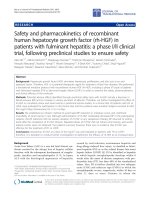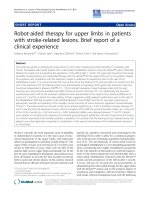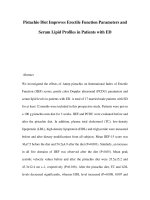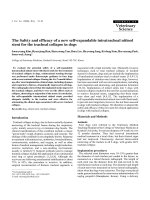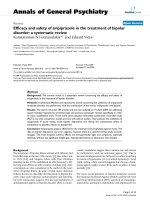Effect and safety of dual anti-human epidermal growth factor receptor 2 therapy compared to monotherapy in patients with human epidermal growth factor receptor 2-positive breast cancer: A
Bạn đang xem bản rút gọn của tài liệu. Xem và tải ngay bản đầy đủ của tài liệu tại đây (705.14 KB, 9 trang )
Zhang et al. BMC Cancer 2014, 14:625
/>
RESEARCH ARTICLE
Open Access
Effect and safety of dual anti-human epidermal
growth factor receptor 2 therapy compared to
monotherapy in patients with human epidermal
growth factor receptor 2-positive breast cancer:
a systematic review
Xiao Zhang1†, Xin-Ji Zhang1†, Tian-Yi Zhang1†, Fei-Fei Yu1, Xin Wei2, Ye-Sheng Li3 and Jia He1*
Abstract
Background: Dual anti-human epidermal growth factor receptor 2 (HER2) therapies have been shown to improve
outcomes of HER2-positive breast cancer patients. We undertook a systematic review to compare treatment outcomes
for patients who received single or combined anti-HER2 therapies.
Methods: We identified randomized control trials that compared dual anti-HER2 therapy and anti-HER2 monotherapy
in patients with HER2-positive breast cancer. Outcomes included pathologic complete response (pCR), overall survival
(OS), progression-free survival (PFS), and adverse events. Included in the analysis were seven trials that recruited 2,609
patients.
Results: In the neoadjuvant setting, the pooled pCR rate in the dual anti-HER2 therapy and monotherapy groups in
combination with chemotherapy was 54.8% and 36%, respectively. This difference was statistically significant (relative
risk, 1.56; 95% confidence interval (CI), 1.23–1.97; p < 0.001). In the metastatic setting, dual anti-HER2 therapy
demonstrated significant benefits in both PFS (hazard ratio (HR), 0.71; 95% CI, 0.62–0.81; p < 0.001) and OS (HR, 0.68;
95% CI, 0.57–0.82; p < 0.001). Subgroup analyses indicated that the addition of chemotherapy to dual anti-HER2 therapy
could greatly improve pCR in the neoadjuvant settings. However, in the metastatic setting, similar PFS and OS were
found in patients receiving dual anti-HER2 therapy with or without chemotherapy. Dual anti-HER2 therapy was
associated with more frequent adverse events than monotherapy, but no statistical differences were observed in
cardiac toxicity.
Conclusions: This systematic review provides a summary of all the data currently available, and confirms the benefits
and risks of dual anti-HER2 therapy for HER2-positive breast cancer.
Keywords: anti-HER2 therapy, HER2-positive breast cancer, Systematic review
* Correspondence:
†
Equal contributors
1
Department of Health Statistics, Second Military Medical University,
Shanghai, China
Full list of author information is available at the end of the article
© 2014 Zhang et al.; licensee BioMed Central Ltd. This is an Open Access article distributed under the terms of the Creative
Commons Attribution License ( which permits unrestricted use, distribution, and
reproduction in any medium, provided the original work is properly credited. The Creative Commons Public Domain
Dedication waiver ( applies to the data made available in this article,
unless otherwise stated.
Zhang et al. BMC Cancer 2014, 14:625
/>
Background
Despite advances in early diagnosis and treatment, breast
cancer remains a significant public health concern; more
than a million new cases are diagnosed each year, resulting
in 400,000 deaths worldwide [1-3]. Human epidermal
growth factor receptor 2 (HER2) protein is overexpressed
in 15–20% of all breast cancers (HER2-positive breast cancer) and is associated with a poor outcome [4,5].
The development of trastuzumab, a monoclonal antibody against HER2, has dramatically changed the prognosis for HER2-positive breast cancer patients [6]. Multiple
randomized controlled trials (RCTs) have shown that trastuzumab therapy improves patient outcomes, and consequently trastuzumab has become the standard treatment
for HER2-positive breast cancer patients in both the neoadjuvant and metastatic settings [7,8]. Following trastuzumab, lapatinib, an anti-HER2 tyrosine kinase inhibitor,
was approved for use, in combination with capecitabine,
for the treatment of HER2-positive metastatic breast cancer that has progressed with standard treatment [9,10].
Despite these improvements, resistance to these drugs
remains a challenge, and novel therapeutic approaches are
required [11,12]. The effect of combining different antiHER2-targeted agents is one therapeutic strategy currently
under investigation [13]. Laboratory studies have shown
that dual anti-HER2 therapy can block the signaling from
HER2 and its related HER family members more completely, leading to increased cell death and tumor shrinkage in HER2-positive models of breast cancer [14]. The
addition of pertuzumab, an anti-HER2 monoclonal antibody, to trastuzumab and docetaxel therapy significantly
increases progression-free survival (PFS) for patients with
HER2-positive metastatic breast cancer (median PFS, 19.5
versus 12.4 months) [15]. These impressive results have
provided a strong rationale for conducting randomized
controlled studies evaluating trastuzumab in combination
with lapatinib or pertuzumab for HER2-positive breast
cancer in both the adjuvant and metastatic settings. In this
study, we conduct a systematic review of these RCTs to
summarize the benefits and risks of dual anti-HER2 therapy, as compared with monotherapy, for HER2-positive
breast cancer patients.
Methods
Data sources, search strategy, and selection criteria
The systematic review was performed according to the
Quality of Reporting of Meta-analyses (QUORUM) guidelines [16]. We systematic searched PubMed, EmBase,
MEDLINE, and the Cochrane Central Registered Controlled Trials for studies conducted prior to May 2013,
using the following keywords: trastuzumab, pertuzumab,
lapatinib, and breast cancer. The search was limited to
randomized clinical trials, but without language restrictions. In addition, the American Society of Clinical
Page 2 of 9
Oncology (ASCO) Annual Meeting proceedings and the
San Antonio Breast Cancer Symposium Meeting abstracts
from 2004 to 2013 were individually searched for relevant
randomized clinical trials. An independent search of relevant reviews and meta-analyses regarding trastuzumab,
pertuzumab, or lapatinib was also conducted to ensure
that no studies were missed. We reviewed each publication, and only the most recent or complete report of clinical trials was included when duplicate publications were
identified. Efforts were also made to contact the study authors when relevant data were not clear.
The goal of this study was to evaluate the efficacy and
safety of dual anti-HER2 therapy compared to monotherapy. Thus, only RCTs comparing dual anti-HER2
therapy (lapatinib, trastuzumab, or pertuzumab) with
anti-HER2 monotherapy, with or without chemotherapy,
in breast cancer were eligible. Phase I trials and singlearm phase II trials were excluded because of an absence
of controls. Eligible studies had to meet the following inclusion criteria: studies had to 1) be prospective phase II
and III trials with HER2 breast cancer patients, and 2)
assign patients randomly to anti-HER2 single agent or
combination treatment. The literature search and selection were undertaken independently by two investigators
(Xiao Zhang and Fei-Fei Yu), and any disagreement was
investigated by a third investigator (Xin-Ji Zhang) until a
consensus was reached.
Data extraction and quality assessment
Data extraction and collection was performed independently by two reviewers (Xiao Zhang and Fei-Fei Yu)
using a standardized protocol. Disagreements were adjudicated by a third reviewer (Xin-Ji Zhang) after referring
to the original articles. The following information was
extracted from each included study for baseline characteristics: the first author’s surname, publication year, original country, age, number of patients per arm, dose and
duration of anti-HER2 therapy, type/dose of chemotherapy, median follow-up period, and outcome measures.
End points of interest included overall survival (OS),
PFS, pathologic complete response (pCR), and adverse
events (AEs). The quality of the trials included in this
study were assessed using the Jadad scale [17]. The trials
were assessed on the basis of randomization, concealment of treatment allocation, blinding, completeness of
follow-up, and the use of intention-to-treat analysis.
Statistical analysis
We extracted the adjusted hazard ratio (HR) and corresponding 95% confidence interval (CI) from each RCT to
estimate the pooled HR, and corresponding 95% CI, for
OS and PFS in the dual anti-HER2 therapy and monotherapy groups. We also allocated dichotomous frequency
data to assess the pooled relative risks (RRs), and
Zhang et al. BMC Cancer 2014, 14:625
/>
corresponding 95% CI, of pCR and each AEs in the dual
anti-HER2 therapy and monotherapy groups. Included in
the analysis were five three-arm trials, with two antiHER2 monotherapy arms and one dual anti-HER2 therapy
study. The two anti-HER2 monotherapy arms were
merged into one group by adding the sample size and the
number of events in each arm. Subgroup analyses were
performed according to the addition of chemotherapy and
the component drugs of dual anti-HER2 therapy (trastuzumab + lapatinib or trastuzumab + pertuzumab). When
there was no statistically significant heterogeneity, a
pooled effect was calculated using a fixed-effect model;
otherwise, a random-effect model was employed. Heterogeneity of treatment effects between trials was evaluated
using the chi-square (χ2) test and I-squared (I2) statistic
[18]. We also assessed the probability of publication bias
using the Egger’s [19] and Begg–Mazumdar [20] tests.
Statistical analyses were carried out using STATA 11.0
(State Corporation, Lake Way, Texas, USA). A two-tailed
p value <0.05 was considered statistically significant.
Results
Search results and trial characteristics
We identified 737 potentially relevant trials from our initial electronic search, and excluded 685 trials after a preliminary review. The remaining 52 studies were retrieved
for detailed assessment. Of these, 44 articles were excluded because they contained no combination therapy
Figure 1 Flow diagram of the trial search and selection process.
Page 3 of 9
group, were phase II trials without a control arm, or they
were not phase II or phase III studies. An additional article was included by searching ASCO 2012 Annual Meeting abstracts [21]. A further two studies were excluded
because they were duplicates [22,23]; only the most recent
reports were included [15,24]. Therefore, a total of seven
[15,21,24-28] RCTs were included in our final analysis,
which included data on 2,609 individual patients (Figure 1).
The design characteristics of the included trials are presented in Table 1. The role of dual anti-HER2 therapy in
the neoadjuvant setting was evaluated in five trials
[21,25-28] and two trials [15,24] investigated dual antiHER2 therapy in the metastatic setting. All the breast cancer patients were HER2-positive. The quality of the trials
was assessed according to the pre-determined criteria of
the Jadad score. Overall, three trials had a Jadad score of 5
[23,26,27], three trials had a score of 4 [21,25,28], and one
trial had a score of 3 [24].
pCR in neoadjuvant studies
pCR was evaluated in a total of five trials [21,25-28], all
which investigated the effect of anti-HER2 therapy in the
neoadjuvant settings. In these trials, anti-HER2 agents
were combined with chemotherapy: paclitaxel in three trials [21,26,27], FEC in one trial [28], and docetaxel in the
remaining one trial [25]. There was also one arm without
chemotherapy in the Neo-Sphere trial [25], and this arm
was excluded in the pooled analysis. The pooled pCR rate
Study
Phase Treatment
staus
CHER-LOB26
(2012)
2
27
NeoALTTO
(2012)
NSABP B-4121
(2012)
NeoSphere25
(2012)
Holmes
(2012)
28
EGF10490024
(2012)
CLEOPATRA15
(2012)
3
3
2
NA
3
3
Treatment
arms
Neoadjuvant T
Pts no.
Dosage
Chemotherapy Treatment duration
Median Jada Followage
score up (m)
36
2 mg/kg weekly (loading 4 mg/kg)
Paclitaxel
26 weeks
50
5
NA
L
39
1500 mg daily
Paclitaxel
26 weeks
49
NA
L+T
46
1000 mg daily + 2 mg/kg weekly (loading 4 mg/kg)
Paclitaxel
26 weeks
49
NA
Neoadjuvant L
149
1500 mg daily
Paclitaxel
18 weeks
50
T
154
2 mg/kg weekly (loading 4 mg/kg)
Paclitaxel
18 weeks
49
L+T
5
NA
NA
152
1000 mg daily + 2 mg/kg weekly (loading 4 mg/kg)
Paclitaxel
18 weeks
50
Neoadjuvant T
177
2 mg/kg weekly (loading 4 mg/kg)
Paclitaxel
12 weeks
NA
L
171
1250 mg daily
Paclitaxel
13 weeks
NA
L+T
171
750 mg daily + 2 mg/kg weekly (loading 4 mg/kg)
Paclitaxel
14 weeks
NA
107
6 mg/kg q3w (loading 8 mg/kg)
Docetaxel
12 weeks
50
T+P
107
6 mg/kg q3w (loading 8 mg/kg) + 420 mg/kg q3w
(loading 840 mg/kg)
docetaxel
13 weeks
50
NA
T+P
107
6 mg/kg q3w (loading 8 mg/kg) +420 mg/kg q3w
(loading 840 mg/kg)
NO
14 weeks
49
NA
P
96
420 mg/kg q3w (loading 840 mg/kg)
docetaxel
15 weeks
49
Neoadjuvant T
33
2 mg/kg weekly (loading 4 mg/kg)
FEC
26 weeks
NA
Neoadjuvant T
Metastatic
Metastatic
NA
4
NA
NA
NA
4
4
NA
NA
NA
L
34
1250 mg daily
FEC
27 weeks
NA
NA
L+T
33
750 mg daily + 2 mg/kg weekly
FEC
28 weeks
NA
NA
L+T
148
1000 mg daily + 2 mg/kg weekly
No
Until progression or
unacceptable toxicity
51
L
148
1500 mg daily
No
Until progression or
unacceptable toxicity
51
P+T
402
6 mg/kg q3w (loading 8 mg/kg) + 420 mg/kg q3w
(loading 840 mg/kg)
Docetaxel
Until progression or
unacceptable toxicity
54
Placebo + T
406
6 mg/kg q3w (loading 8 mg/kg)
Docetaxel
Until progression or
unacceptable toxicity
54
3
12.8
8.7
5
30
30
Page 4 of 9
Abbreviations: T Trastuzumab, L Lapatinib, P Pertuzumab, pts no patients number, mg milligram, kg kilogram, Pacl Paclitaxel, FEC Fluorouracil (5FU), epirubicin, and cyclophosphamide; q3w three-weekly,
NA Not available, m month.
Zhang et al. BMC Cancer 2014, 14:625
/>
Table 1 Character of the included studies
Zhang et al. BMC Cancer 2014, 14:625
/>
Page 5 of 9
was 54.8% (278 of 508 patients; 95% CI, 0.46–0.63) in the
dual therapy group compared with 35.6% (442 of 995 patients; 95% CI, 0.24–0.50) in the monotherapy group. The
difference in pCR between dual agents and single antiHER2 agents was significant (RR, 1.56; 95% CI, 1.23–1.97;
p < 0.001), with no evidence of significant publication bias
(Egger’s test, P = 0.624; Begg-Mazumdar test, P = 0.9370;
Figure 2).We noted some evidence of heterogeneity in the
magnitude of this effect across the included studies (p =
0.006, I2 = 72.3%), which was mostly attributable to inclusion of the NSABP B-41 study [21]. A sensitivity analysis
that excluded the NSABP B-41 study resulted in a similar
RR (1.74; 95% CI, 1.49–2.03; p < 0.001) with much reduced
heterogeneity (p = 0.67, I2 = 0.00%).
[24]. In this study, 296 patients were randomly assigned to
receive either lapatinib + trastuzumab (dual anti-HER2
therapy group) or lapatinib monotherapy (control group).
The median PFS was 11.1 and 8.1 weeks in the dual antiHER2 therapy and control groups, respectively. Median
OS was 14 months for the dual anti-HER2 therapy group
and 9.5 months for the lapatinib alone group. The dual
anti-HER2 therapy group showed significant improvements in PFS (HR, 0.74; 95% CI, 0.58–0.94; P = 0.011) and
OS (HR, 0.74; 95% CI, 0.57–0.97; P = 0.026). Although
these two trials had different patient populations and settings, both showed a significant improvement in OS and
PFS with dual anti-HER2 therapy.
PFS and OS in metastatic studies or setting
Subgroup analysis
In our analysis, two studies [15,24] investigated the effect
of dual anti-HER2 therapy in the metastatic setting. The
CLEOPATRA study was a phase III study that included
808 patients with HER2-positive metastatic breast cancer
[15]. In this study, patients were randomized to first-line
treatment of pertuzumab + trastuzumab + docetaxel (dual
anti-HER2 therapy group) or trastuzumab + docetaxel +
placebo (control group). The median PFS was 18.7 months
in the dual anti-HER2 therapy group and 12.4 months in
the control group. The difference in PFS was significant
(HR, 0.69; 95% CI, 0.58–0.81; P < 0.001). Furthermore, a
significant benefit in OS was also observed in patients allocated to the dual anti-HER2 therapy treatment group
compared with individuals assigned to the control group
(HR, 0.66; 95% CI 0.52 − 0.84; p < 0.001). The median OS
for patients allocated to the control group was 37.6 months
but was not reached in the dual anti-HER2 therapy group.
Another phase III study (EGF104900) enrolled patients
with HER2-positive metastatic breast cancer whose disease had progressed during prior trastuzumab therapy
Subgroup analyses were performed to determine whether
the type of neoadjuvant chemotherapy influenced the efficacy of dual anti-HER2 therapy. We found that the benefit
of dual anti-HER2 therapy on pCR was similar among different chemotherapies. Detailed information regarding
these analyses is summarized in Table 2.
We also performed subgroup analyses based on the
component drugs of dual anti-HER2 therapy (trastuzumab + lapatinib or trastuzumab + pertuzumab). The results of this subgroup analysis indicated that there were
improvements in pCR in dual anti-HER2 therapies consisting of trastuzumab + lapatinib (RR, 1.52; 95% CI, 1.15–
2.01) and trastuzumab + pertuzumab (RR, 1.72; 95% CI,
1.27–2.34; Table 2). Compared with monotherapy, dual
anti-HER2 therapy consisting of trastuzumab + lapatinib
showed a decrease in the HR for disease progression and
death of 26% and 29%, respectively. Similar benefits in
PFS (HR, 0.69; 95% CI, 0.58–0.81) and OS (HR, 0.66; 95%
CI, 0.52–0.84) were also observed with trastuzumab + pertuzumab dual anti-HER2 therapy.
Study
RR ( 95% CI )Weight( % )
CHER−LOB 2012
1.82 ( 1.10, 2.99)
12.6
NeoALTTO 2012
1.90 ( 1.49, 2.41)
22.5
NeoSphere 2012
1.72 ( 1.27, 2.34)
19.6
NSABP B−41 2012
1.17 ( 1.01, 1.37)
26.2
Holmes 2011
1.48 ( 1.07, 2.03)
19.0
Total (p=0.002)
Heterogeneity
1.56 ( 1.23, 1.97)
100.0
χ2
2
I
.02
.2
1
Risk ratio
5
50
Figure 2 Meta-analysis of pathologic complete response between dual anti-HER2 therapy and monotherapy groups.
Zhang et al. BMC Cancer 2014, 14:625
/>
Page 6 of 9
Table 2 Subgroup analysis based on the type of
chemotherapy and the component of dual agents
Subgroup
Reference
The type of Chemotherapy
Cardiac toxicity
pCR
21,25,26,27,28
1.56 (1.23,1.97)
21,26,27
1.55 (1.06,2.28)
Paclitaxel
FEC
28
1.48 (1.07,2.03)
Docetaxel
25
1.72 (1.27,2.34)
L+T
21,26,27,28
1.52 (1.15,2.01)
P+T
25
1.72 (1.27,2.34)
Component of dual agents
Abbreviations: T Trastuzumab, L Lapatinib, P Pertuzumab.
Relative risk of AEs
The use of dual anti-HER2 therapy was associated with
an increase in serious AEs (RR, 1.22; 95% CI, 1.03–1.46;
p = 0.024). In addition, dual anti-HER2 therapy increased
the risk of grade 3–4 diarrhea (RR, 1.64; 95% CI, 1.26–
2.13; p < 0.001), all grades of dermatologic toxicity (RR,
1.41; 95% CI, 1.19–1.68; p < 0.001), and febrile neutropenia (RR, 1.55; 95% CI, 1.08–2.23; p = 0.143). No statistically significant differences were observed between the
two arms for neutropenia (RR, 0.99; 95% CI, 0.88–1.10;
p = 0.645), hepatic toxicity (RR, 1.01; 95% CI, 0.66–1.55;
p = 0.818), grade 3-4 dermatologic toxicity (RR, 1.28;
95% CI, 0.73–2.23; p = 0.378), nausea (RR, 1.04; 95% CI,
0.90–1.20; p = 0.597), or fatigue (RR, 1.01; 95% CI, 0.86–
1.19; p = 0.879; Figure 3).
The risk of heart failure was reported in six trials
[15,21,24-27]. Overall, there was no statistically significant difference in the risk of heart failure between dual
anti-HER2 therapy and monotherapy (RR, 0.79; 95% CI,
0.23–2.68; p = 0.708). There were five trials [15,24-27]
that reported data for left ventricular ejection fraction
(LVEF) decline, but no statistically significant difference
in risk between the treatment groups was found (RR,
1.12; 95% CI, 0.51–2.44; p = 0.773; Figure 4).
Discussion
This systematic review summarizes all the available published, randomized evidence on the efficacy and safety of
dual anti-HER2 therapy compared with monotherapy in
HER2-positve breast cancer patients. Preclinical studies
have suggested that combining different HER2 inhibitors
with complementary mechanisms of action can help
maximize the suppression of oncogenic processes involved
in disease progression. Consequently, an increasing number of clinical trials have been performed to investigate
this promising therapeutic approach [15,24,25]. Combining data from all the currently published trials, this
systematic review confirms the benefit of dual HER2directed therapy over monotherapy for HER2-positve
breast cancer.
By pooling the data from the included trials, we showed
that dual anti-HER2 therapy significantly improves pCR
Heterogeneity
χ2
2
I
Adverse Event
OR (95% CI)
Diarrhea
1.37 (0.97, 1.95) 0.075
42.22
90.5% 0.000
Diarrhea Grade3 -4
1.64 (1.26, 2.13) <0.001
2.18
0.0%
0.703
Nausea
1.04 (0.90, 1.20) 0.597
0.01
0.0%
0.908
HepaƟc Toxicity
1.01 (0.66, 1.55) 0.818
1.90
47.4% 0.168
Dermatologic Toxicity
1.41 (1.19, 1.68) <0.001
2.69
0.0%
0.441
Dermatologic Toxicity Grade 3-4
1.28 (0.73, 2.23) 0.378
0.20
0.0%
0.978
Rash
1.12 (0.74, 1.69)
0.586
9.12
78.1%
0.010
Rash Grade 3-4
1.09 (0.33, 3.54)
0.890
0.04
0.0%
0.834
MucosiƟs
1.28 (1.04, 1.59) 0.021
1.16
0.0%
0.560
FaƟgue
1.01 (0.86, 1.19) 0.879
0.10
0.0%
0.951
Neutropenia
0.99 (0.88, 1.10) 0.645
4.74
36.8% 0.191
Febrile Neutropenia
1.55 (1.08, 2.23) 0.143
2.60
23.0% 0.273
Serious Adverse Event
1.22 (1.03, 1.46) 0.024
3.57
44.0% 0.168
.0
.2
1
5
P-value
50
OR
Figure 3 Meta-analysis of adverse events between dual anti-HER2 therapy and monotherapy groups.
P-value
Zhang et al. BMC Cancer 2014, 14:625
/>
Page 7 of 9
RR (95% CI)
Study
Weight(%)
Heart failure
NSABP B−41
CLEOPATRA
EGF104900
NeoALTTO
CHER−LOB
NeoSphere
0.14 ( 0.02, 1.09)
6.3
0.63 ( 0.37, 1.05)
30.0
2.96 ( 0.31, 28.13)
5.2
5.96 ( 0.24, 145.46) 2.8
(Excluded)
(Excluded)
0.79 ( 0.23, 2.68)
44.2
2
2
Heterogeneity ( χ =5.77 I =48.0%, p=0.123
Total(p=0.708)
LVEF decline events
EGF104900
CHER−LOB
CLEOPATRA study
NeoALTTO
NeoSphere
2.61 ( 0.71, 9.66)
12.3
0.54 ( 0.02, 12.96)
2.8
0.62 ( 0.35, 1.11)
28.2
1.00 ( 0.09, 10.91)
4.7
2.82 ( 0.48, 16.60)
7.8
1.12 ( 0.51, 2.44)
55.8
2
2
Heterogeneity ( χ =5.80 I =31.0%, p=0.215
Total(p=0.773)
.02
.2
1
5
50
Risk ratio
Figure 4 Meta-analysis of cardiac toxicity between dual anti-HER2 therapy and monotherapy groups.
rate in the neoadjuvant setting (RR, 1.56; 95% CI, 1.23–
1.97; p < 0.001). Hence, dual anti-HER2 therapy might be
an attractive strategy in this setting. In the metastatic setting, dual anti-HER2 therapy, compared to monotherapy,
demonstrated significant benefits for OS and PFS in the
EGF104900 and CLEOPATRA studies. However, because
of the limited data regarding metastatic disease, these benefits require further study.
Despite the advantages of dual anti-HER2 therapy in
the neoadjuvant settings, a number of questions have
arisen: 1) does the type of chemotherapy alter the efficacy of dual anti-HER2 therapy; and 2) which combination of the HER2 inhibitors has optimal efficacy for
HER2-positive breast cancer. In this study, subgroup
analyses were conducted to address these questions.
When grouped by the type of chemotherapy, the improvement in the pCR rate with dual anti-HER2 therapy
was similar, regardless of the specific chemotherapies
used. Furthermore, similar efficacy was observed with
trastuzumab + pertuzumab and trastuzumab + lapatinib.
Based on current data, it appears that the type of
chemotherapy and specific components of dual antiHER2 therapy have little impact on the efficacy of the
treatment. However, due to the limited number of trials
in each subgroup, these results need to be validated in
further studies.
Our study also raises some safety concerns. As the
HER2 signaling pathway plays an important role in cardiac physiology [29], we investigated the risk of cardiac
AEs. We found that no increased risk of cardiac toxicity
was associated with dual anti-HER2 therapy, which is
consistent with the results of a previous study conducted by Valachis et al. [30]. However, we found that
some other toxicities were more frequent in patients
who received dual anti-HER2 therapy, particularly grade
3–4 diarrhea, dermatologic toxicity, mucosis, febrile
neutropenia, and other serious AEs. Clinicians should
take note of this, since the incidence of AEs substantially affects a patient’s quality of life, and may lead to
discontinuation of dual treatment.
Several limitations of this systematic review should be
acknowledged. Firstly, data from the ongoing ALTTO
and MARIANNE [14] trials are still unavailable. Secondly, our results are based on published data and presented clinical trials; individual patient data were not
unavailable. Thirdly, because the results of this metaanalysis are confined to trastuzumab + lapatinib or trastuzumab + pertuzumab, the results are not necessarily
applicable to treatments using other drug combinations. In
addition, some subgroup analyses were based on limited
studies, and the results should be interpreted with caution.
Conclusions
This systematic review shows that, according to the present
available data, dual anti-HER2 therapy seems to be more effective than monotherapy in the neoadjuvant setting. In the
metastatic setting, limited data is available and further
evaluation of the role of dual anti-HER2 treatment is required. However, it is reasonable to believe that a shift
towards a dual therapeutic approach will yield clinically
meaningful improvements for patients with HER2-postive
breast cancer. However, given the increased risk of AEs
associated with dual anti-HER2 therapy, it is important for
health care practitioners to be aware of the potential risks
and to provide close monitoring to improve patient
outcome.
Zhang et al. BMC Cancer 2014, 14:625
/>
Page 8 of 9
Competing interests
The authors declare that they have no competing interests.
11.
Authors’ contributions
Conception/design: JH, X-JZ, XZ. Collection and/or assembly of data: XZ,
F-FY. Data analysis and interpretation: XZ, XW, Y-SL. Manuscript writing: XZ,
X-JZ, T-YZ. All authors read and approved the final manuscript.
Acknowledgements
This work is supported by the grants from the National Natural Science
Foundation of China (NO. 81373105), the Key Discipline Construction of
Evidence-based Public Health in Shanghai (NO. 12GWZX0602), The Ministry
of Science and Technology of China (Project NOs. 2009ZX09312-025,
2008ZX09312-007, and 2011ZXJ09202-015), and the Fund for Youth in
Second Military Medical University (NO. 2012QN10). The funders had no role
in the study design, data collection, analysis, decision to publish, or
preparation of the manuscript. The corresponding author has full access to
all the data in the study and had final responsibility for the decision to
submit for publication.
12.
13.
14.
15.
Author details
1
Department of Health Statistics, Second Military Medical University,
Shanghai, China. 2Renji Hospital, Shanghai Jiao Tong University School of
Medicine, Shanghai, China. 3Department of Special Treatment, Eastern
Hepatobiliary Hospital, Second Military Medical University, Shanghai, China.
16.
Received: 12 March 2014 Accepted: 21 August 2014
Published: 28 August 2014
17.
References
1. Brollo J, Curigliano G, Disalvatore D, Marrone BF, Criscitiello C, Bagnardi V,
Kneubil MC, Fumagalli L, Locatelli M, Manunta S, Goldhirsch A: Adjuvant
trastuzumab in elderly with HER-2 positive breast cancer: a systematic
review of randomized controlled trials. Cancer Treat Rev 2013, 39(1):44–50.
2. Patani N, Mokbel K: Herceptin and breast cancer: an overview for
surgeons. Surg Oncol 2010, 19(1):e11–e21.
3. Binns C, Low WY, Lee MK: Breast cancer: an increasing public health
problem in the Asia pacific region. Asia Pac J Public Health 2013,
25(5):364–367.
4. Ross JS, Slodkowska EA, Symmans WF, Pusztai L, Ravdin PM, Hortobagyi GN:
The HER-2 receptor and breast cancer: ten years of targeted anti-HER-2
therapy and personalized medicine. Oncologist 2009, 14(4):320–368.
5. Vogel UF: Confirmation of a low HER2 positivity rate of breast
carcinomas - limitations of immunohistochemistry and in situ
hybridization. Diagn Pathol 2010, 5:50.
6. Burris HA 3rd, Rugo HS, Vukelja SJ, Vogel CL, Borson RA, Limentani S,
Tan-Chiu E, Krop IE, Michaelson RA, Girish S, Amler L, Zheng M, Chu YW,
Klencke B, O'Shaughnessy JA: Phase II study of the antibody drug
conjugate trastuzumab-DM1 for the treatment of human epidermal
growth factor receptor 2 (HER2)-positive breast cancer after prior
HER2-directed therapy. J Clin Oncol 2011, 29(4):398–405.
7. Tonyali O, Benekli M, Berk V, Coskun U, Ozkan M, Yildiz R, Ucgul E, Sevinc A,
Uncu D, Demirci U, Buyukberber S: Efficacy and toxicity of Trastuzumab
and Paclitaxel plus Capecitabine in the first-line treatment of HER2positive metastatic breast cancer. J Cancer Res Clin Oncol 2013,
139(6):981–986.
8. Rimawi MF, Mayer IA, Forero A, Nanda R, Goetz MP, Rodriguez AA, Pavlick
AC, Wang T, Hilsenbeck SG, Gutierrez C, Schiff R, Osborne CK, Chang JC:
Multicenter phase II study of neoadjuvant lapatinib and trastuzumab
with hormonal therapy and without chemotherapy in patients with
human epidermal growth factor receptor 2-overexpressing breast
cancer: TBCRC 006. J Clin Oncol 2013, 31(14):1726–1731.
9. Geyer CE, Forster J, Lindquist D, Chan S, Romieu CG, Pienkowski T, JagielloGruszfeld A, Crown J, Chan A, Kaufman B, Skarlos D, Campone M, Davidson
N, Berger M, Oliva C, Rubin SD, Stein S, Cameron D: Lapatinib plus
capecitabine for HER2-positive advanced breast cancer. N Engl J Med
2006, 355(26):2733–2743.
10. Xu BH, Jiang ZF, Chua D, Shao ZM, Luo RC, Wang XJ, Liu DG, Yeo W, Yu SY,
Newstat B, Preston A, Martin AM, Chi HD, Wang L: Lapatinib plus
capecitabine in treating HER2-positive advanced breast cancer: efficacy,
18.
19.
20.
21.
22.
23.
24.
25.
26.
safety, and biomarker results from Chinese patients. Chin J Cancer 2011,
30(5):327–335.
Scaltriti M, Eichhorn PJ, Cortes J, Prudkin L, Aura C, Jimenez J, Chandarlapaty S,
Serra V, Prat A, Ibrahim YH, Guzman M, Gili M, Rodriguez O, RodrIguez S, Perez
J, Green SR, Mai S, Rosen N, Hudis C, Baselga J: Cyclin E amplification/
overexpression is a mechanism of trastuzumab resistance in HER2+ breast
cancer patients. Proc Natl Acad Sci U S A 2011, 108(9):3761–3766.
Nagata Y, Lan KH, Zhou X, Tan M, Esteva FJ, Sahin AA, Klos KS, Li P, Monia
BP, Nguyen NT, Hortobagyi GN, Hung MC, Yu D: PTEN activation
contributes to tumor inhibition by trastuzumab, and loss of PTEN
predicts trastuzumab resistance in patients. Cancer Cell 2004,
6(2):117–127.
Alvarez RH, Hortobagyi GN: Dual human epidermal growth factor
receptor 2 blockade for the treatment of HER2-positive breast cancer.
Breast Cancer 2013, 20(2):103–110.
Konecny GE: Emerging strategies for the dual inhibition of HER2-positive
breast cancer. Curr Opin Obstet Gynecol 2013, 25(1):55–65.
Swain SM, Kim SB, Cortes J, Ro J, Semiglazov V, Campone M, Ciruelos E,
Ferrero JM, Schneeweiss A, Knott A, Clark E, Ross G, Benyunes MC, Baselga J:
Pertuzumab, trastuzumab, and docetaxel for HER2-positive metastatic
breast cancer (CLEOPATRA study): overall survival results from a
randomised, double-blind, placebo-controlled, phase 3 study.
Lancet Oncol 2013, 14(6):461–471.
Moher D, Cook DJ, Eastwood S, Olkin I, Rennie D, Stroup DF: Improving the
quality of reports of meta-analyses of randomised controlled trials: the
QUOROM statement. Quality of reporting of meta-analyses. Lancet 1999,
354(9193):1896–1900.
Jadad AR, Moore RA, Carroll D, Jenkinson C, Reynolds DJ, Gavaghan DJ,
McQuay HJ: Assessing the quality of reports of randomized clinical trials:
is blinding necessary? Control Clin Trials 1996, 17(1):1–12.
Higgins JP, Thompson SG, Deeks JJ, Altman DG: Measuring inconsistency
in meta-analyses. BMJ 2003, 327(7414):557–560.
Egger M, Davey Smith G, Schneider M, Minder C: Bias in meta-analysis
detected by a simple, graphical test. BMJ 1997, 315(7109):629–634.
Begg CB, Mazumdar M: Operating characteristics of a rank correlation
test for publication bias. Biometrics 1994, 50(4):1088–1101.
Robidoux A, Tang G, Rastogi P, Geyer CE, Azar CA, Atkins JN, Fehrenbacher
L, Bear HD, Baez-Diaz L, Sarwar S, Margolese RG, Farrar WB, Brufsky AM,
Shibata HR, Bandos H, Paik S, Costantino JP, Swain SM, Mamounas EP,
Wolmark N: Lapatinib as a component of neoadjuvant therapy for HER2positive operable breast cancer (NSABP protocol B-41): an open-label,
randomised phase 3 trial. J Clin Oncol 2013, 14(12):1183–1192.
Blackwell KL, Burstein HJ, Storniolo AM, Rugo H, Sledge G, Koehler M, Ellis C,
Casey M, Vukelja S, Bischoff J, Baselga J, O'Shaughnessy J: Randomized
study of Lapatinib alone or in combination with trastuzumab in women
with ErbB2-positive, trastuzumab-refractory metastatic breast cancer.
J Clin Oncol 2010, 28(7):1124–1130.
Baselga J, Cortes J, Kim SB, Im SA, Hegg R, Im YH, Roman L, Pedrini JL,
Pienkowski T, Knott A, Clark E, Benyunes MC, Ross G, Swain SM:
Pertuzumab plus trastuzumab plus docetaxel for metastatic breast
cancer. N Engl J Med 2012, 366(2):109–119.
Blackwell KL, Burstein HJ, Storniolo AM, Rugo HS, Sledge G, Aktan G, Ellis C,
Florance A, Vukelja S, Bischoff J, Baselga J, O'Shaughnessy J: Overall survival
benefit with lapatinib in combination with trastuzumab for patients with
human epidermal growth factor receptor 2-positive metastatic breast
cancer: final results from the EGF104900 Study. J Clin Oncol 2012,
30(21):2585–2592.
Gianni L, Pienkowski T, Im YH, Roman L, Tseng LM, Liu MC, Lluch A,
Staroslawska E, de la Haba-Rodriguez J, Im SA, Pedrini JL, Poirier B, Morandi
P, Semiglazov V, Srimuninnimit V, Bianchi G, Szado T, Ratnayake J, Ross G,
Valagussa P: Efficacy and safety of neoadjuvant pertuzumab and
trastuzumab in women with locally advanced, inflammatory, or early
HER2-positive breast cancer (NeoSphere): a randomised multicentre,
open-label, phase 2 trial. Lancet Oncol 2012, 13(1):25–32.
Guarneri V, Frassoldati A, Bottini A, Cagossi K, Bisagni G, Sarti S, Ravaioli A,
Cavanna L, Giardina G, Musolino A, Untch M, Orlando L, Artioli F, Boni C,
Generali DG, Serra P, Bagnalasta M, Marini L, Piacentini F, D'Amico R,
Conte P: Preoperative chemotherapy plus trastuzumab, lapatinib, or both
in human epidermal growth factor receptor 2-positive operable breast
cancer: results of the randomized phase II CHER-LOB study. J Clin Oncol
2012, 30(16):1989–1995.
Zhang et al. BMC Cancer 2014, 14:625
/>
Page 9 of 9
27. Baselga J, Bradbury I, Eidtmann H, Di Cosimo S, de Azambuja E, Aura C,
Gomez H, Dinh P, Fauria K, Van Dooren V, Aktan G, Goldhirsch A, Chang TW,
Horvath Z, Coccia-Portugal M, Domont J, Tseng LM, Kunz G, Sohn JH,
Semiglazov V, Lerzo G, Palacova M, Probachai V, Pusztai L, Untch M, Gelber
RD, Piccart-Gebhart M: Lapatinib with trastuzumab for HER2-positive early
breast cancer (NeoALTTO): a randomised, open-label, multicentre, phase
3 trial. Lancet 2012, 379(9816):633–640.
28. Holmes FA, Nagarwala YM, Espina VA, Liotta LA, Danso MA, Gallagher RI,
McIntyre K, Osborne CRC, Mahoney JM, Florance AM, Anderson TC,
O'Shaughnessy J, Anderson TC, O'Shaughnessy J: Correlation of molecular
effects and pathologic complete response to preoperative lapatinib and
trastuzumab, separately and combined prior to neoadjuvant breast
cancer chemotherapy. J Clin Oncol 2011, 29(suppl):abstr 506.
29. Zhao YY, Sawyer DR, Baliga RR, Opel DJ, Han X, Marchionni MA, Kelly RA:
Neuregulins promote survival and growth of cardiac myocytes.
Persistence of ErbB2 and ErbB4 expression in neonatal and adult
ventricular myocytes. J Biol Chem 1998, 273(17):10261–10269.
30. Valachis A, Nearchou A, Polyzos NP, Lind P: Cardiac toxicity in breast
cancer patients treated with dual HER2 blockade. Int J Cancer 2013,
133(9):2245–2252.
doi:10.1186/1471-2407-14-625
Cite this article as: Zhang et al.: Effect and safety of dual anti-human
epidermal growth factor receptor 2 therapy compared to monotherapy
in patients with human epidermal growth factor receptor 2-positive
breast cancer: a systematic review. BMC Cancer 2014 14:625.
Submit your next manuscript to BioMed Central
and take full advantage of:
• Convenient online submission
• Thorough peer review
• No space constraints or color figure charges
• Immediate publication on acceptance
• Inclusion in PubMed, CAS, Scopus and Google Scholar
• Research which is freely available for redistribution
Submit your manuscript at
www.biomedcentral.com/submit




